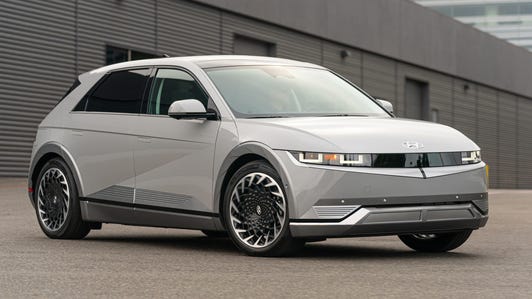Watch Hyundai turn an Ioniq 5 EV into a giant air purifier – Roadshow [CNET]
In the process of developing a new car, automakers build dozens — if not hundreds — of prototype and preproduction models that can’t legally be sold to the public. A few are held on to for further development or preservation purposes, but most get recycled or crushed, which feels incredibly wasteful. When faced with that end-of-the-road conundrum for one particular Ioniq 5 EV preproduction SUV, Hyundai let its engineers loose to find it a second, more useful life. Their solution? A large air purifier.
As shown in a new promo video, Hyundai’s engineers first reduced the all-electric crossover to its constituent parts, then set about using many of the vehicle’s components to craft a large air filter. The result, which looks a bit like a smart speaker or a 2013-to-2019 Apple Mac Pro tower, is actually significantly larger than you might expect. The cylindrical housing itself is slightly larger around than the 20-inch alloy wheel that makes up the top of the purifier’s case, and the side panels are made from parts of the vehicle’s doors and hood.
Inside, the cabin air filter and a cooling fan form the heart of the system, ostensibly activated using the infotainment touchscreen that’s mounted to the housing. Even the Ioniq 5’s emblem makes an appearance on the case, alongside the vehicle’s charismatic pixelated LED taillamps and the digital instrument cluster readout.

The recycling of other car parts into things like new industrial steel, playground flooring and glass beads has been going on for decades. Today, roughly 90% of vehicles are recyclable, but EVs present their own challenges — namely, the problem of what to do with costly and complex battery packs. We’ve already been seeing second-life trials commence in earnest for EV batteries as supplementary power supplies for homes, offices and power grids for over a decade already, but there’s still a lot more work to be done before such processes become economically viable.
In the meantime, Hyundai’s creative reworking of prototype parts appears to be more for the Korean automaker’s marketing purposes than it is an attempt at an actual production-intent solution for end-of-life vehicle components, but untethering engineers to focus on parts repurposing is a useful thought exercise that could well pay future dividends. If nothing else, the lateral thinking at work here is interesting, and the end product quite compelling. Besides, the decision to turn these parts into an air purifier seems fitting, not only because EVs are inherently cleaner, but because the name “Ioniq 5” has always sounded like you might find it on the box of a HEPA air filter at Home Depot anyway.

![watch-hyundai-turn-an-ioniq-5-ev-into-a-giant-air-purifier-–-roadshow-[cnet]](https://i0.wp.com/upmytech.com/wp-content/uploads/2022/01/47238-watch-hyundai-turn-an-ioniq-5-ev-into-a-giant-air-purifier-roadshow-cnet.jpg?resize=800%2C445&ssl=1)



![ea-announces-new-lord-of-the-rings-mobile-rpg-[game-informer]](https://i0.wp.com/upmytech.com/wp-content/uploads/2022/05/65136-ea-announces-new-lord-of-the-rings-mobile-rpg-game-informer.jpg?resize=390%2C205&ssl=1)
![nasa-to-unveil-first-james-webb-space-telescope-images-next-week:-how-to-watch-–-cnet-[cnet]](https://i0.wp.com/upmytech.com/wp-content/uploads/2022/07/75400-nasa-to-unveil-first-james-webb-space-telescope-images-next-week-how-to-watch-cnet-cnet.jpg?resize=390%2C205&ssl=1)
![rootmetrics:-south-korea’s-‘brilliant’-5g-will-spur-other-countries-in-2021-[venturebeat]](https://i0.wp.com/upmytech.com/wp-content/uploads/2020/12/17099/rootmetrics-south-koreas-brilliant-5g-will-spur-other-countries-in-2021-venturebeat.jpg?resize=390%2C205&ssl=1)